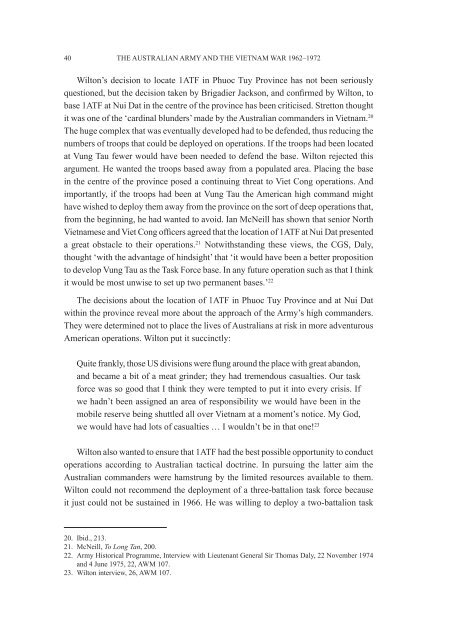conference proceedings - Australian Army
conference proceedings - Australian Army
conference proceedings - Australian Army
You also want an ePaper? Increase the reach of your titles
YUMPU automatically turns print PDFs into web optimized ePapers that Google loves.
40<br />
THE AUSTRALIAN ARMY AND THE VIETNAM WAR 1962–1972<br />
Wilton’s decision to locate 1ATF in Phuoc Tuy Province has not been seriously<br />
questioned, but the decision taken by Brigadier Jackson, and confirmed by Wilton, to<br />
base 1ATF at Nui Dat in the centre of the province has been criticised. Stretton thought<br />
it was one of the ‘cardinal blunders’ made by the <strong>Australian</strong> commanders in Vietnam. 20<br />
The huge complex that was eventually developed had to be defended, thus reducing the<br />
numbers of troops that could be deployed on operations. If the troops had been located<br />
at Vung Tau fewer would have been needed to defend the base. Wilton rejected this<br />
argument. He wanted the troops based away from a populated area. Placing the base<br />
in the centre of the province posed a continuing threat to Viet Cong operations. And<br />
importantly, if the troops had been at Vung Tau the American high command might<br />
have wished to deploy them away from the province on the sort of deep operations that,<br />
from the beginning, he had wanted to avoid. Ian McNeill has shown that senior North<br />
Vietnamese and Viet Cong officers agreed that the location of 1ATF at Nui dat presented<br />
a great obstacle to their operations. 21 Notwithstanding these views, the CGS, Daly,<br />
thought ‘with the advantage of hindsight’ that ‘it would have been a better proposition<br />
to develop Vung Tau as the Task Force base. In any future operation such as that I think<br />
it would be most unwise to set up two permanent bases.’ 22<br />
The decisions about the location of 1ATF in Phuoc Tuy Province and at Nui Dat<br />
within the province reveal more about the approach of the <strong>Army</strong>’s high commanders.<br />
They were determined not to place the lives of <strong>Australian</strong>s at risk in more adventurous<br />
American operations. Wilton put it succinctly:<br />
Quite frankly, those US divisions were flung around the place with great abandon,<br />
and became a bit of a meat grinder; they had tremendous casualties. Our task<br />
force was so good that I think they were tempted to put it into every crisis. If<br />
we hadn’t been assigned an area of responsibility we would have been in the<br />
mobile reserve being shuttled all over Vietnam at a moment’s notice. My God,<br />
we would have had lots of casualties … I wouldn’t be in that one! 23<br />
Wilton also wanted to ensure that 1ATF had the best possible opportunity to conduct<br />
operations according to <strong>Australian</strong> tactical doctrine. In pursuing the latter aim the<br />
<strong>Australian</strong> commanders were hamstrung by the limited resources available to them.<br />
Wilton could not recommend the deployment of a three-battalion task force because<br />
it just could not be sustained in 1966. He was willing to deploy a two-battalion task<br />
20. Ibid., 213.<br />
21. McNeill, To Long Tan, 200.<br />
22. <strong>Army</strong> Historical Programme, Interview with Lieutenant General Sir Thomas Daly, 22 November 1974<br />
and 4 June 1975, 22, AWM 107.<br />
23. Wilton interview, 26, AWM 107.

















